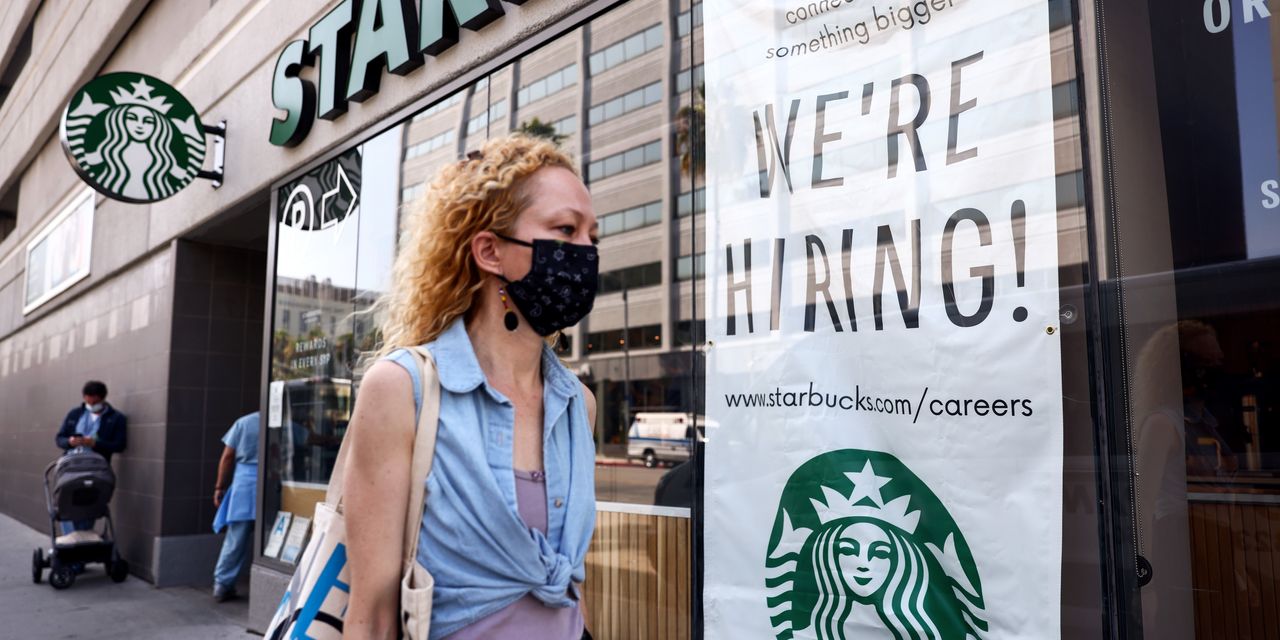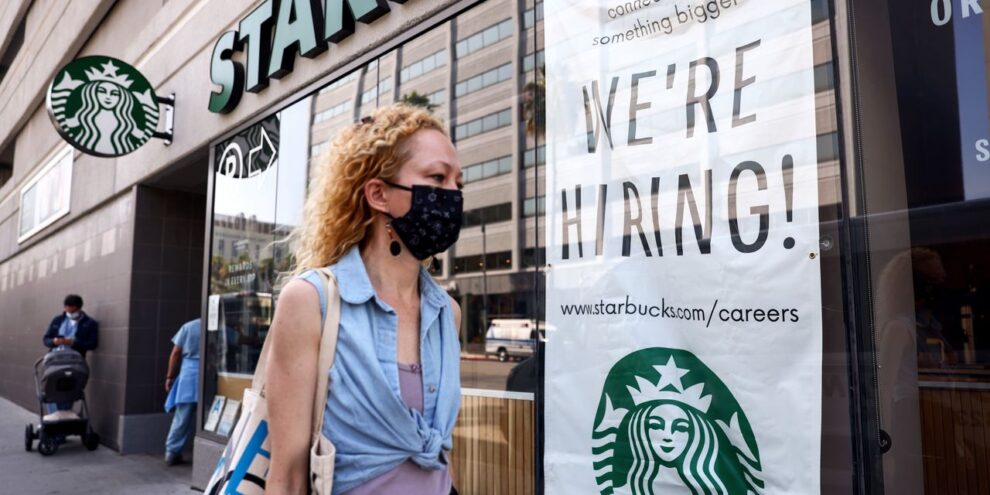
U.S. stock indexes were trading mostly down Friday afternoon, in a session that has been turbulent, following a monthly employment report that offered something for both optimists and pessimists, even if the headline figure came in far below economists’ estimates.
The Labor Department report is still being parsed by investors, who appear to be concluding that the monthly employment update won’t derail the Federal Reserve’s intention to wind down accommodative policies and eventually hike rates to combat inflation in 2022.
What are stock indexes doing?
- The Nasdaq Composite Index COMP fell about 122 points, or 0.8%, to 14,959 but had hit an intraday low at 14,877.63.
- The Dow Jones Industrial Average DJIA, +0.15% rose 63 points, or 0.2%, to about 36,297, after it carved out an intraday low at 36,111.53.
- The S&P 500 index SPX, -0.23% slipped almost 11 points, or 0.3%, to 4,684, but touched a low at 4,662,74.
- The small-capitalization Russell 2000 index RUT, -0.96% was trading off 0.9% at 2,196.
- For the week, Nasdaq Composite is down 4.2%, the Dow is flat, the S&P 500 is looking at a 1.6% drop, while the Russell 2000 is off 2.6%, FactSet data show.
On Thursday, the Dow fell 171 points, or 0.5%, to 36,236, the S&P 500 slipped 0.1% and the Nasdaq Composite eased 0.1%. The Nasdaq is now 6% below its November peak.
What’s driving markets?
The Dow Jones Industrial Average was holding on to modest gains Friday afternoon, while other major U.S. stock benchmarks were in the red as investors assessed the latest labor-market data.
The U.S. economy added 199,000 jobs in December, the Labor Department reported on Friday, well below the forecast from economists polled by The Wall Street Journal for a 422,000 rise for the month, highlighting some impact of the spread of Omicron on the jobs market.
While the headline number of the jobs report was worse than expected, the economy still looked “hot” when considering details such as the drop in the unemployment rate and increase in average hourly earnings, according to Bob Doll, chief investment officer of Crossmark Global Investments.
Read: The U.S. jobs report is not as weak as looks for the second month in a row. Here’s why
The U.S. unemployment rate dropped to 3.9% from 4.2%, while average hourly earnings jumped 19 cents, or 0.6%, to $31.31, the jobs report showed, proving a bright spot for some.
“We have a strong economy and we have an inflation problem and the Fed’s behind the curve,” Doll said by phone Friday. The jobs report gives the Federal Reserve “more leeway to get on with it,” he said, pointing to market expectations for the Fed to begin hiking its benchmark interest rate this year.
Market participants may be viewing Friday’s job report as lackluster but also not damaging enough to give central bankers reason to pause what has been expressed as a plan to tighten financial policy sooner and faster than had previously been expected.
“U.S. employers are having to pay up to get people back into the workforce and this is something that the Fed will consider when they look at the timeline for when to make their first move,” wrote Michael Hewson, chief market analyst at CMC Markets U.K., in a daily report.
Omicron poses “challenges” for labor-force participation that aren’t fully captured in Friday’s jobs report as the spread of the variant picked up after the employment data was collected for it, cautioned Luke Tilley, chief economist at Wilmington Trust, in a phone interview Friday. “It is a very tight labor market,” he said, citing the struggles of businesses to hire workers in the pandemic.
The jobs report also comes during a week in which the yield on the 10-year Treasury TMUBMUSD10Y, 1.770% surged to around 1.8% — pressuring growth stocks and bolstering financials. The continued climb for government debt was helping to contribute to pressure on the yield-sensitive tech sector, with the Nasdaq Composite looking at its work weekly slide since Feb. 12 of 2021. Similarly, the large-capitalization Nasdaq-100 index NDX, -0.85% was down more than 4% and on track for its sharpest weekly slump since Feb. 26.
Read: Value stocks have pulled ahead of growth in recent weeks. Is it a head-fake?
Financial shares SP500.40, +1.26% were up about 5.3% so far this week but energy SP500.10, +1.44% was the really winner, rising more than 10% as investors bet on a better performance for cyclicals in 2022 as rates rise.
Those moves came as San Francisco Fed President Mary Daly on Friday said that she endorses a gradual rate increase at the same time as an unwind of the central bank’s roughly $9 trillion balance sheet, which she says should come sooner than the last normalization cycle.
“I would prefer to see us adjust the policy rate gradually and move into balance sheet reduction earlier than we did in the last cycle,” Daly said at the annual meeting of the American Economic Association.
Which companies are in focus?
- Shares of Gap Inc. GPS, -2.34% were in focus after Kanye West, now known as Ye, announced a partnership with luxury label Balenciaga on a Yeezy collection that will be available at Gap. Shares of the retailer were down 2.3%.
- Boot Barn Holdings Inc. BOOT edged up 0.3% after the retailer pre-announced fiscal third-quarter results, delivering numbers that beat Street expectations.
- CinCor Pharma Inc. CINC, rose 0.5% in its market debut Friday, after the Massachusetts-based biopharmaceutical company’s upsized initial public offering priced overnight at $16 a share, in the middle of the expected range of between $15 and $17 a share.
- Willis Towers Watson WLTW said it would change its Nasdaq stock ticker symbol to “WTW” at the open of market trading on Monday, Jan. 10.
How are other assets faring?
- The yield on the 10-year Treasury note rose 3.6 basis points Friday to 1.769% for the biggest weekly gain since September 2019 based on 3 p.m. Eastern Time levels, according to Dow Jones Market Data. Treasury yields and prices move in opposite directions.
- The ICE U.S. Dollar Index DXY, a measure of the currency against a basket of six major rivals, was down 0.6% Friday afternoon and off 0.2% for the week.
- Oil futures CL00 fell, with West Texas Intermediate crude for February delivery CLG22, -0.57% settling 0.7% lower at $78.90 a barrel. Still, front-month contract prices for the U.S. benchmark rose 4.9% for the week.
- Gold futures GC00, +0.30% for February delivery GCG22, +0.30% closed 0.5% higher, settling at $1,797.40 an ounce, but with the most-active contract down 1.7% for the week.
- Bitcoin BTCUSD was down around 3.4% at about $41,665.
- The Stoxx Europe 600 SXXP closed 0.4% lower for a weekly slump of 0.3%, while London’s FTSE 100 UKX rose 0.5%, contributing to the resource-heavy index’s 1.4% weekly advance.
- The Shanghai Composite SHCOMP fell 0.2% on Friday and notched a 1.7% weekly drop, while the Hang Seng Index HSI rose 1.8%, helping it post a weekly gain of 0.4%, and Japan’s Nikkei 225 NIK finished flat but down 1.1% on the week.
—Steve Goldstein contributed to this report.









